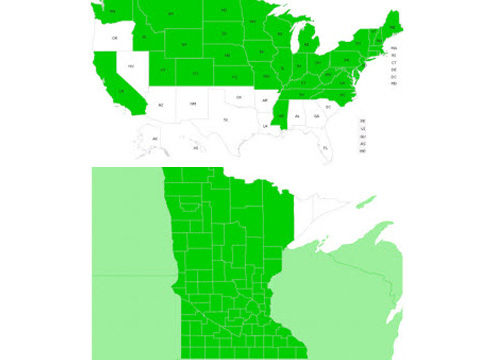What should I do about buckthorn on my property?
Simply put: remove it yourself or have it removed.
If the buckthorn plants are smaller than a pencil, you may simply pull it from the ground or spray it with a properly mixed foliar treatment of Garlon4, Impel, and 2,4-D.
If the diameter of the trunk is larger than a pencil you should use the “cut-stump method” Cut the buckthorn off, leaving approx. 3-4 inches of the trunk exposed, and spray the stump and surrounding bark with a mixture of Garlon4 and Impel Red. Attempting to pull buckthorn this large is not a good option, because many of the fibrous roots in the ground will remain intact. These roots will continue to grow and re-sprout into buckthorn plants in a very short amount of time.
Another method than can be useful is the “basal bark treatment” method (aka “basal stem treatment method”). Apply a mixture of Triclopyr ester (i.e., Garlon 4 or Pathfinder II) mixed with an oil diluent ( i.e. Impel Red, Bark Oil Blue, kerosene or diesel oil) using a low volume sprayer directly to the bark of buckthorn from the root collar up about 12-18 inches. This method works best on trunks less than 3 inches in diameter.
Warning: over-application of this mixture (i.e., over-spray and/or run-off) will greatly increase the odds of potential non-target injury to the surrounding desirable trees. The advantage to this method is that you can kill the buckthorn without having to remove the tree itself. This is often a method preferred by parks and other large parcels of land where removing the buckthorn entirely (i.e. using the cut-stump method) is simply cost prohibitive. The disadvantages of using the basal bark treatment method are that because you’re leaving the tree intact, you’re still minimizing the amount of sunlight allowed through its canopy of branches to the forests understory (thus aiding in shading-out future desirable growth). The potential for non-target injury is much greater when compared to the cut-stump method. It’s also worth mentioning that the basal bark method has not been proven to be as effective when compared to using the cut-stump method (especially on larger buckthorn greater than 3” in diameter). Hence the reason we prefer and encourage other to use the cut-stump method whenever possible.
There are other methods of removal such as Girdle herbicide application, Crown removal, and controlled burns. We won’t go into these alternative methods because they are typically cost prohibitive and/or not as effective as the “tried and true” cut-stump method.
How long does removal usually take, and how much does it cost? We typically charge $65.00 per man-hour, plus chemical & equipment fees (i.e. bobcat, wood chipper, etc.).
Removing buckthorn is an arduous process that is only effective when done methodically. Each buckthorn tree that is cut needs to be dragged over to a wood chipper, fed through the machine, and have its stump treated with a very potent herbicide that must be applied with precision (one can’t simply “hose it down” without killing more than the buckthorn).
Because Buckthorn varies in size and density it is impossible to give an average amount of time (i.e. how long it would take 2 men to clear one acre of buckthorn). Hence the reason most companies work “by the hour”. For larger projects consisting of several acres of land, a general rule of thumb is $900 per thousand square feet of infested forest.













